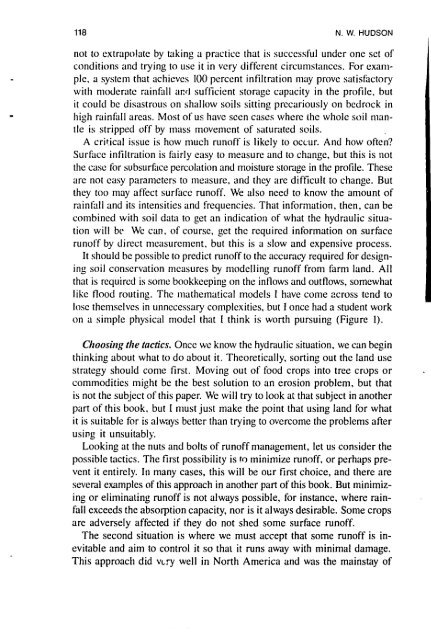Conservation farming on steep lands - USAid
Conservation farming on steep lands - USAid
Conservation farming on steep lands - USAid
You also want an ePaper? Increase the reach of your titles
YUMPU automatically turns print PDFs into web optimized ePapers that Google loves.
118 N. W. HUDSON<br />
not to extrapo!ate by taking a practice that is successful under <strong>on</strong>e set of<br />
c<strong>on</strong>diti<strong>on</strong>s and trying to use it in very different circumstances. For example.<br />
a systeni that achieves 100 percent infiltrati<strong>on</strong> may prove satisfactory<br />
with moderate rainfall acd sufficient storage capacity in the profile, but<br />
it could be disastrous <strong>on</strong> shallow soils sitting precariously <strong>on</strong> bedrock in<br />
high rainf:ill areas. Most of us have seen cases where ihe whole soil mantle<br />
is stripped off by rnass movement of saturated soils.<br />
A critical issue is how much runoff is likely to occur. And how often?<br />
Surface infiltrati<strong>on</strong> is fairly easy to measure and to change, but this is not<br />
the case for subsurface percolati<strong>on</strong> and moisture storage in the profile. These<br />
are not easy parameters to measure, and they ilre difficult to change. But<br />
they too nlay affect surface runoff. We also need to know the amount of<br />
rainfall and its intensities and frequencies. That informati<strong>on</strong>, then, can be<br />
combined with soil data to get an indicati<strong>on</strong> of what the hydraulic situati<strong>on</strong><br />
will be We can, of course, get the required informati<strong>on</strong> <strong>on</strong> surface<br />
runoff by direct measurement, but this is a slow and expensive process.<br />
It should be possible to predict runoff to the accuracy required for designing<br />
soil c<strong>on</strong>servati<strong>on</strong> nieasures by nlodelling runoff from farni land. All<br />
that is required is some bookkeeping <strong>on</strong> the inflows and outflows, somewhat<br />
like flood routing. The mathematical models I have come zcross tend to<br />
lose themselves in unnecessary complexities, but I <strong>on</strong>ce had a student work<br />
<strong>on</strong> a simple physical model that I think is worth pursuing (Figure 1).<br />
Clzoosi~tg tlte tactics. Once we know the hydrdulic situati<strong>on</strong>, we can begin<br />
thinking about what to do about it. Theoretically, sorting out the land use<br />
strategy should come tirst. Moving out of food crops into tree crops or<br />
commodities might be the best soluti<strong>on</strong> to an erosi<strong>on</strong> problem, but that<br />
is not the subject of this paper. We will try to look at that subject in another<br />
part of this book, but I must just make the point that using land for what<br />
it is suitable for is alwdys better than trying to overcome the problems after<br />
using it unsuitably.<br />
Looking at the nuts and bolts of runoff management, let us c<strong>on</strong>sider the<br />
possible tactics. The first possibility is !o minimize runoff, or perhaps prevent<br />
it entirely. In many cases, this will be ocr first choice, and there are<br />
several examples of this approach in another part of this book. But minimizing<br />
or eliminating runoff is not always possible, for instance, where rainfall<br />
exceeds the absorpti<strong>on</strong> capacity, nor is it always desirable. Some crops<br />
are adversely affected if they do not shed some surface runoff.<br />
The sec<strong>on</strong>d situati<strong>on</strong> is where we must accept that some runoff is inevitable<br />
and aim to c<strong>on</strong>trol it so that it runs away with minimal damage.<br />
This approach did vcry well in North America and was the mainstay of
















